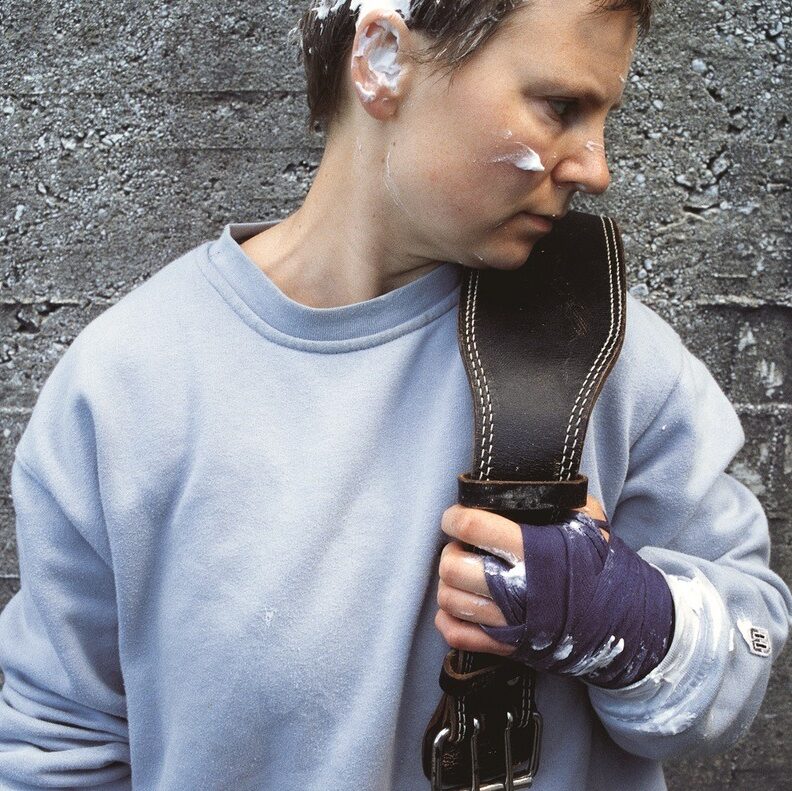Veronica Diesen, Writer and Lecturer; Bergen 2001
The present text is on Rita Marhaug’s exhibition entitled as The Geography of Intimacy in which the artist has staged her three children in relation to the themes concerning gender and identity.
The writer considers the performance art starting mainly as a protest against the institutionalization of the object of art. By creation of art from one’s own activity, artists endeavored to tear themselves loos from the traditional art-object. This activity also proved to marginalize the understanding and interpretation of art itself, as the artist no longer saw it as necessary to exhibit objects in established galleries. To the contrary, general public spaces became a significant arena for the communication of art. Another important element which performance brought to the art scene was its emphasis upon the activity of creation, which again spawned even greater and richer possibilities for artists to express themselves.
Marhaug For example exhibited her 13 + 35 (2000) at the private apartment-gallery Døgnfluen (meaning the ephemeral fly whose lifespan is but one day) in Bergen. Here Marhaug showed a performance with her teenage daughter Emilie. Both were clad in clothing, with arms in comradeship draped over each other’s shoulders. Within the space of the fifteen-minute performance, menstrual blood began to appear on their clothing. Menstruation implies something that binds one to responsibility and duty. Rita Marhaug’s performance points to the process of maturation, which happens to women while they are as yet young girls.
But what does it mean to be ‘woman’? In the book The Second Sex Simone de Beauvoir describes how one is not born as a woman, but how one becomes one. According to de Beauvoir, the understanding of gender is an important aspect in the process of constructing our identity. We all have, of necessity, required the relative conventions and values that are grounded in the culture into which we are born. But precisely because these values are not eternally true but of a relative character, we need not take them for granted or accept them without further ado. For example, in most cultures the man has played a dominant role. He has been perceived as the neutral subject defining his environment, which includes woman. In the West today, however, the belief in man’s neutrality is collapsing. We have begun to address the problems men have in relation to their identity, problems which, through tradition, have been laid on them.
For what is a man? Is he something by the power of his physical strength or his so-called active sexuality? Rita Marhaug has worked with questions tied to what we view as typical masculinity. She has done this in performances using sports of strength, such as weight lifting, boxing and karate. As de Beauvoir pointed out, the masculine gender has been viewed as both more real and more neutral then the feminine. A man’s dominance has been seen as part of this superiority. The male strength has also been perceived as belonging to something more primitive and more original than the feminine predilection for self-decoration and foolishness. Today, however, this physical dominance is not particularly important for most occupations. Thus, male physical dominance is confirmed primarily through sports. Sports of strength and endurance such as football, boxing weight lifting, etc., are a significant channel for a man’s confirmation of his masculine identity. By contrast, in her artistic performances, Marhaug has tried to show how these concepts such as strength and endurance are most of all cultural factors, which are also steered by fetishes and various sorts of staging.
These masculine ‘fetishisms of strength’ pervade this entire exhibition. For example, in the photo series of six pictures entitled Outside the Garage (Utenfor garasjen) (2001), Marhaug appears together with her daughter Emilie in front of a gray concrete wall. Both are clad in the daughter’s hip-hop cloths and the mother’s boxing and weight lifting gear. In the second series of large photos called In the Garden (I hagen) (2001), both the mother and the daughter Sofie are portrayed in the same red flower dress. All the pictures are taken in the winter and the grass is frozen, creating a clear contrast to the summery light dress the models wear.
In all these portraits there is a form of ‘identification’ through the use of identical clothing. The roles between artist-child and mother-child function in different ways, simultaneously the expression helps to intensify the feeling of each person’s individuality. These pictorial situations can be said to contain a’ relational esthetic’, where the point of tension between the viewer and mother-Emilie, between mother-Sofie, between Rita-Sonia, etc., emphasizes how differently our impression of each individual person can be, all according to which situation we see them in: viewed according to a relational aesthetic, no permanent relation exists, not even that between mother-daughter. According to Deleuse/Guattari, understanding the world via dualistic concepts, such as man-woman, masculine-feminine, gives a very fallacious picture of our field of experience. As an alternative of this view, they suggest a philosophy where language is bent away from its traditional categories, opening up the possibility of multiplication: instead of saying either-or, why not ask about the nuances in between?
Another important aspect about The Geography of Intimacy is Marhaug’s emphasis on marginalized and trivial expressions, in that she ties her art to the private sphere of the every day. The convention is also used in the series of large photo-based intaglio prints. The photos were spawned on a journey Marhaug and her family made last summer from Sunnmøre to Hordaland. All these pictures show a familiar phenomenon of western Norwegian experience: the winding, narrow asphalt roads couched between steep vertical cliffs and fjords, all seen from inside a compact and cramped family car, as it is in motion. Here the spectacular and oh so nationally romantic nature is related to the triviality of today’s auto-culture. A key to interpret this series of pictures is the emphasis on everyday experience. The enclosed space of the car, the monotonous driving and the repetitive landscape are the elements that form the geography of intimacy. More like mapping a story that constitutes its own validity through what we recon and recognize: the intimate.
ــــــــــــــــ
https://www.ritamarhaug.com/uploads/2/3/3/3/23330060/performance_as_it_relates_to_gender_idetity_and_power.pdf
 Projects
Projects  Performance as It Relates to Gender, Identity and Power
Performance as It Relates to Gender, Identity and Power

